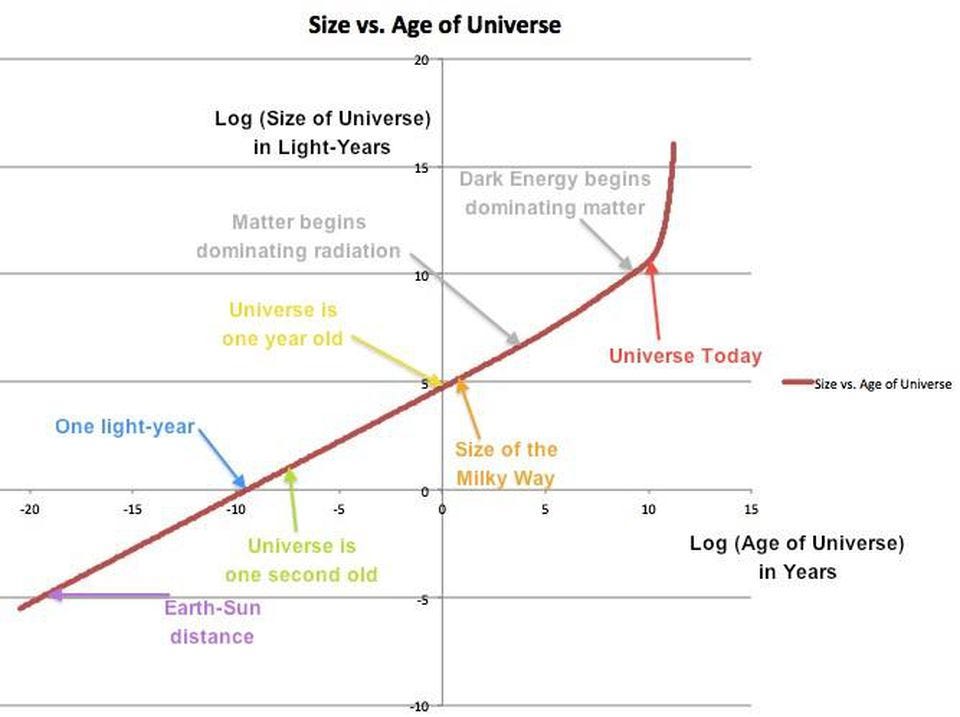The furthest object observe is this
My question is, how far away from our position was it when its light that we now see was emitted?
I know it was emitted ~13 BY ago but how small was the Universe then?
The furthest object observe is this
My question is, how far away from our position was it when its light that we now see was emitted?
I know it was emitted ~13 BY ago but how small was the Universe then?
JudgeMental said:
The furthest object observe is this
My question is, how far away from our position was it when its light that we now see was emitted?I know it was emitted ~13 BY ago but how small was the Universe then?
Great question.
At the end of the inflationary era, the diameter of the visible universe was 0.88 mm.
At the time of the cosmic microwave background (CMB), at 379,000 years after the big bang, at a redshift of 1098, which means the universe was about 84.6 million light years across.
The most distant known object is the galaxy GN-z11 has a redshift of 11.09. 400 million years after the Big Bang.
The new object, at 690 million years after the Big Bang, has a redshift of 7.54.
For those ages, try reading it off the following chart. 100 million years, take the log to get 10^8. That gives a universe size somewhere between 10^8 and 10^9 light years across.

mollwollfumble said:
JudgeMental said:
The furthest object observe is this
My question is, how far away from our position was it when its light that we now see was emitted?I know it was emitted ~13 BY ago but how small was the Universe then?
Great question.
At the end of the inflationary era, the diameter of the visible universe was 0.88 mm.
At the time of the cosmic microwave background (CMB), at 379,000 years after the big bang, at a redshift of 1098, which means the universe was about 84.6 million light years across.
The most distant known object is the galaxy GN-z11 has a redshift of 11.09. 400 million years after the Big Bang.
The new object, at 690 million years after the Big Bang, has a redshift of 7.54.
For those ages, try reading it off the following chart. 100 million years, take the log to get 10^8. That gives a universe size somewhere between 10^8 and 10^9 light years across.
Or to put it another way, perhaps a tenth the size that it is today.
mollwollfumble said:
JudgeMental said:
The furthest object observe is this
My question is, how far away from our position was it when its light that we now see was emitted?I know it was emitted ~13 BY ago but how small was the Universe then?
Great question.
At the end of the inflationary era, the diameter of the visible universe was 0.88 mm.
At the time of the cosmic microwave background (CMB), at 379,000 years after the big bang, at a redshift of 1098, which means the universe was about 84.6 million light years across.
The most distant known object is the galaxy GN-z11 has a redshift of 11.09. 400 million years after the Big Bang.
The new object, at 690 million years after the Big Bang, has a redshift of 7.54.
For those ages, try reading it off the following chart. 100 million years, take the log to get 10^8. That gives a universe size somewhere between 10^8 and 10^9 light years across.
A decent scale on that wouldn’t go astray.
mollwollfumble said:
… 100 million years, take the log to get 10^8.
…
Maths sure has changed since I went to school.
btm said:
mollwollfumble said:
… 100 million years, take the log to get 10^8.
…
Maths sure has changed since I went to school.
It’s the new maths.
sibeen said:
btm said:
mollwollfumble said:
… 100 million years, take the log to get 10^8.
…
Maths sure has changed since I went to school.
It’s the new maths.
More like the new, new, new maths.
sibeen said:
mollwollfumble said:
JudgeMental said:
The furthest object observe is this
My question is, how far away from our position was it when its light that we now see was emitted?I know it was emitted ~13 BY ago but how small was the Universe then?
Great question.
At the end of the inflationary era, the diameter of the visible universe was 0.88 mm.
At the time of the cosmic microwave background (CMB), at 379,000 years after the big bang, at a redshift of 1098, which means the universe was about 84.6 million light years across.
The most distant known object is the galaxy GN-z11 has a redshift of 11.09. 400 million years after the Big Bang.
The new object, at 690 million years after the Big Bang, has a redshift of 7.54.
For those ages, try reading it off the following chart. 100 million years, take the log to get 10^8. That gives a universe size somewhere between 10^8 and 10^9 light years across.
A decent scale on that wouldn’t go astray.
Noted.
Let’s try this. https://ned.ipac.caltech.edu/help/cosmology_calc.html
Cosmology calculator 2 might be the one, giving past horizon distance.
Plug in redshift = 0. Horizon distance = 47218.83 million light years. The current size of the visible universe.
Plug in redshift = 7.54. Horizon distance = size of universe = 2087.44 million light years, smaller by a factor of 22.5.
Plug in redshift = 11.09. Horizon distance = size of universe =1239.47 million light years
Plug in redshift = 1098. Horizon distance = size of universe =1.43 million light years